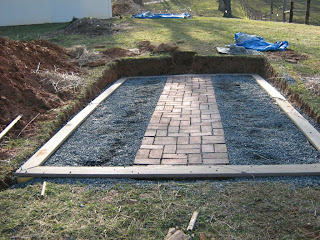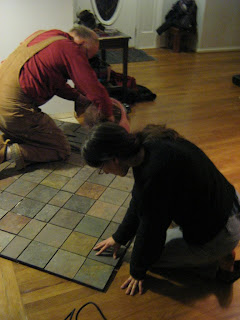Well, we've been a little busy in 2010. As most of you know, Kristen and I were married in May and we're expecting a baby in January. This doesn't mean that farm and garden stuff has stopped, however, but the blog posts sort of have. Anyway, here is a rapid update!

The first new thing we did this year was raise chickens. We decided to pick them out ourselves from a big batch of day-old chicks a friend of ours received in the mail. It's very difficult to tell the difference between roosters and hens at that age, so we thought we were smart by picking out the most active, healthiest-looking chicks in the bunch.
Which turned out to be all roosters. All 13 of them.
Anyway, we raised them over the spring and slaughtered them in the summer. Slaughtering and cleaning birds is a lot of work, but now we have a freezer full of chicken.
Our second batch of chickens came in late summer. We bought these from a hatchery, and 25 out of 26 of them appear to be hens. Half of them are Ameraucanas, and the other half are Rhode Island Reds. We should be getting plenty of eggs this spring.
The second big project for this year was getting sheep. We wanted some kind of grazing animal in order to keep the grass down in our pastures, which we'll be converting into a hazelnut orchard. But we also wanted something that would be easy to care for and move around.
We settled on Katahdin sheep. This is a breed of "hair sheep," which means they shed their winter coats and don't need to be sheared. They're also mostly raised for meat, so lambs are affordable. Katahdins also have a reputation for disease resistance and being able to do well on rough pasture. So we figured this would be a good breed to start out with for people who haven't raised livestock before.
As you can see, there's a lot of variation in color. This is probably due to different strains in the Katahdin mix. The brown-and-white sheep in the back is named Jersey, who might have some Desert Paint in her. The one in the middle, Jackie, shows most of the markings of a Barbados Blackbelly. Annie, in the foreground, might have more St. Croix in her than the others.
We started with 2 ewes and 1 lamb, but returned 1 ewe because she learned to jump the fence. Then we got 3 new lambs, one of which died from barber pole worm (or its side-effects). So now we have 1 ewe and 3 lambs, and we'll probably pick up a few more sheep next spring.
Pictured above is the electronet enclosure we use to rotate pastures. This is basically a portable electric fence made of nylon, steel thread, and plastic support stakes. The energizer is solar-powered, portable, and about the size of a small suitcase.
The electronet enables us to rotate the sheep around our land. More importantly, it will let us pasture the sheep between the rows of young hazelnut trees in a way that will prevent them from eating the leaves or stripping the bark.
If I had to do it over again, I probably would have just used electric tape rather than electronet. The netting gets caught on things very easily, and it's not very well-suited to hilly areas (changes in elevation cause it to lose tension). On the other hand, the net is probably better for keeping out predators, so I'm glad we have it.
It's hard to see, but the little dots at the center of this picture are me and Kevin putting up a perimeter fence along the front of the land. After moving the sheep around a few times, I realized that it would be a good idea to have a "backup" fence in the event they got out. Our property had a barbed-wire fence around it, but sheep slip through those very easily.
For the interior fence-line that separates the pasture/hazelnut field from everything else, I decided to add electric strands to the existing barbed wire, since these would be much cheaper than fencing the entire thing. The nylon-electric strands are very easy to work with. I'm pretty happy with it so far, although it hasn't been fully sheep-tested.
These are peaches from our trees. We canned some of them. We also tried to make peach wine, which might end up being canning vinegar.
We also had a lot of apples this year. It's a little hard to see in this picture, but that is a tree loaded with apples. The variety of different types of apples on our land is hard to keep track of. I can honestly say that some of them have been among the tastiest apples I've ever had, and the pies/crisps/apple sauce/cider we've made from them so far have been much more flavorful then anything I've had store-bought.
Some people say that apples are difficult to deal with because they get a lot of diseases. This is true. But it's also important to understand that there is the picture-perfect, blemish-free apple you get in the grocery store, and then there's what you have on your overgrown apple trees. The first category of apple is indeed hard to get. But the second category isn't. Our trees have been unpruned and unfertilized for years, and they produced many more apples than we had the time or resources to make use of.
Picking apples is only half the battle. Apple-sorting can be difficult work. Above, the Bell family debates the aesthetic, structural, and nutritional merits of each fruit before deciding its fate: pie? Storage? Apple sauce?
Above is a little bit of fall color from the back of our land.
We did a lot of new stuff this year. The garden took a back seat to a lot of the establishment projects we had on the land. We still managed to produce a good number of tomatoes, potatoes, beans, and other vegetables, but we probably wouldn't have had anything without help. My father and sister helped us plant tomatoes, basil, and other vegetables, and Hollis and Jay Wild were once again very generous in keeping our little vegetable starts alive in their greenhouse for many weeks after we should have planted them out.























